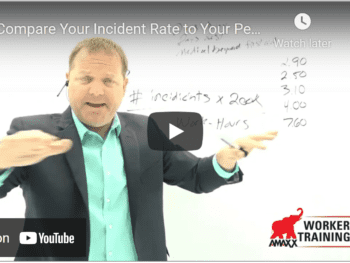I think every person has experienced a lumbar strain at some point in their lives. Whether it be from an acute trauma such as a fall or impact, or from simply lifting too much too fast, the end result is no fun. Lumbar strains are very common workplace injuries, if not the most common injury. These strains cost the employer thousands of dollars in claims expense and lost productivity.
So how do you address this problem? It would be fantastic if there were some sort of universal answer, but sadly there is not. Every employer is different, and more importantly every employee is different. Everyone brings different risk exposures to the table, so you have to look within your own shop and see where to try and reduce the risk. We list seven factors to take into account.
1. Rotate job duties and staff tasks
If an employee’s job is to lift 10lb boxes off the line and place onto a pallet to wrap up and take to shipping, after a few hours that 10lb box feels like it weighs 50lbs. Then imagine that is your job day in and day out, week after week, month after month. Combined with the lifting are the ergonomic factors, body habitus, and overall strength. So just lifting what seems to be a “light weight” box is more complicated than it seems.
A lot of companies have started job rotation. This means that every hour or two, employees move to another part of the plant and do a different type of job for a while, and then they move again and so on until the end of the day. The list could change every week, and the duration and job lists change, so each employee is not doing the exact same thing at the exact same time every day.
The theory behind this is indifferent tasks, at different times, one can only exert certain muscles while giving other muscles a much-needed break, especially in a heavy manual labor type job. Companies that have implemented this theory have had decreases in injuries, and better work performance.
2. Teach proper lifting techniques
Every employer I have been to has a sign on the wall by the loading dock that talks about using smart lifting techniques. “Lift with your legs, not your back” the sign might say, or my personal favorite, “work smarter not harder.” Getting employees to utilize proper lifting techniques is not an easy task, but it is something that must be a constant reminder re-enforced with proper training. Make another employee the “lifting coach” so workers can go to them with questions or concerns. Have a contest to see who can catch the first person lifting with an improper technique and hand out a gas card as a reward. There is a large variety of ways to get workers involved and you will see reduced claim activity because of it.
3. If that fails, bring in a therapist or physician to review ergonomics
Sometimes workers will not listen to anything you have to say about lifting techniques. Sometimes the only way a person learns is by experiencing it themselves. To avoid this have a therapist or doctor come in to talk about the importance of exercises and stretching before heavy work commences. They could also talk about lifting techniques and the risks involved if these techniques are not followed. If only 2-3 workers get the hint and take it to heart, you may see 2-3 less serious back injury claims.
4. Pre-employment physicals
If there is heavy work that needs to be done on a regular basis, properly screen candidates to see if they can do this work without difficulty before starting the job. I have seen several claims in the past where people are injured because they weigh 140lbs, are 5’6”, and are trying to manually lift and move 150lbs. There is no way lifting more than your body weight is safe, no matter how great of shape you are in. So before assigning workers to certain jobs, get a physical to better understand their capabilities. The employee will be grateful if there is a way to prevent them from injuring their back or from sustaining a hernia.
5. Palletizing
This is pretty simple, instead of moving box after box after box onto your trucks for delivery, always stack them on a pallet and get a pallet jack or hi-lo to load the pallet onto the truck. This way workers are not going in and out of the truck a million times not carrying various weights, which could lead to injury. Being able to palletize will depend on the product and demand, but may be an idea not implemented before.
6. Use boxes that have reinforced handles.
If there is a decent amount of boxed weight or you have had a problem with handles breaking or ripping in the past, consider moving the product to a box or packing material with reinforced handles. A lot of distributors make this an option these days and the costs associated are not as bad as one would think. Do research, trend injuries, and try some products out to see if a difference is made. At the very least it does not hurt to have a more stable product that workers can easily maneuver.
7. Reduce weights or products from suppliers
I know of grocery stores that had constant problems with 80-100lb boxes of meat because the handles constantly kept ripping or breaking, leading to shoulder injuries. They saw many problems they demanded their meat provider break the boxes down to 40-50lb with reinforced handles, or else they were going to be searching for a new meat provider. Sure enough, the provider did as they demanded and the grocery store saw a significant decrease in the amount of shoulder and back strains.
Providers may have this option available, but because you never asked, they never gave it to you. Now this does not mean to call up your providers and demand that they do whatever you say, just ask them if they have any other packing options, or packaging options, and see what they say, then go from there.
Summary
Use this as a To-Do list to investigate what options exist for reducing your strain injuries in your workplace. Remember to keep track of the numbers, and see which techniques help and which ones do not. This will vary per employer, so think about where your high-risk areas are and what you can do to reduce your exposure. Any safety implementation is better than nothing at all.
Author Rebecca Shafer, JD, President of Amaxx Risk Solutions, Inc. is a national expert in the field of workers’ compensation. She is a writer, speaker, and website publisher. Her expertise is working with employers to reduce workers’ compensation costs, and her clients include airlines, healthcare, printing/publishing, pharmaceuticals, retail, hospitality, and manufacturing. She is the author of the #1 selling book on cost containment, Manage Your Workers Compensation: Reduce Costs 20-50% www.WCManual.com. Contact: RShafer@ReduceYourWorkersComp.com.
Editor Michael B. Stack, CPA, Director of Operations, Amaxx Risk Solutions, Inc. is an expert in employer communication systems and part of the Amaxx team helping companies reduce their workers compensation costs by 20% to 50%. He is a writer, speaker, and website publisher. www.reduceyourworkerscomp.com. Contact: mstack@reduceyourworkerscomp.com.
Our WORKERS COMP BOOK: www.WCManual.com
WC GROUP: www.linkedin.com/groups?homeNewMember=&gid=1922050/
Do not use this information without independent verification. All state laws vary. You should consult with your insurance broker or agent about workers comp issues.
©2011 Amaxx Risk Solutions, Inc. All rights reserved under International Copyright Law. If you would like permission to reprint this material, contact Info@ReduceYourWorkersComp.com.















